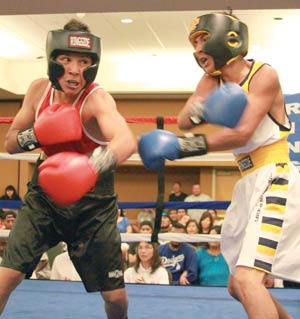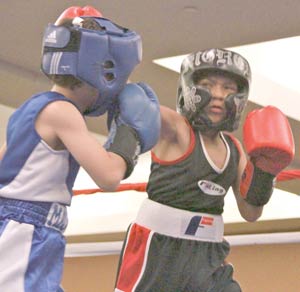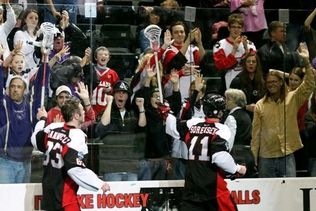
TOP: San Carlos Apache boxer Tommy Nosie (left) spars with Nico Martinez of the Menominee Indian Boxing Club of Wisconsin during the 2013 All Indian Boxing Championships in San Carlos, Ariz.
By Quentin Jodie, Navajo Times
The host city of the 2020 Summer Olympic Games has yet to be determined but Greg Parsons is thinking big.
As the promoter of the 2013 All Indian Boxing Championships, Parsons is prophesying that we’ll have a Native American boxer competing in those games.
“I am looking at some of our 15- and 16-year-old kids,” Parsons said. “Some of them competed at the JO (Junior Olympics) this year and they placed real high.”
Of course that conversation depends on what happens to the fate of the boxing climate within the Native American community.
Parson said in years past, the AIBC has attracted as much as 90 fighters back in his heydays. But last year the event only drew in 32 boxers, which featured only four championship bouts.
This year, however, the numbers were a bit healthier as 52 boxers showed up, which was held at the Apache Gold Casino and Resort in San Carlos, Ariz., on July 4-6.
“We need consistency,” Parson said. “Sometimes this event goes away for one year and it comes back another. It’s really about consistency because for some Native kids this is the biggest tournament they look forward to.
“If this is not around they could lose interest for a whole year,” he added. “If we can keep this going I am sure we can get someone to the Olympics. We just need to so support them and send them places and give them the best fights we can. Maybe we can schedule some international bouts.”

Parsons said it’s imperative to keep the AIBC event ongoing and in the future he would like for the event to be move to other sites.
“I believe it will be back in San Carlos next year but we would like to spread this around as much as we can,” he said.
At this year’s event, Parsons said they ended up with 54 fights including 17 tournament bouts.
“I think we did pretty good,” he said. “We got teams from Canada, Wisconsin, Oregon, Utah, Washington and South Dakota.”
The Wisconsin team, which was represented by the Menominee Indian Boxing Club, brought in eight fighters ranging from 9 to 14 years old.
“Everyone got a ‘W’ this weekend,” said Jason Komanenkin, who co-serves as the MIBC coach along with Arnold Peters and Gerald Wayka Jr. “We are very happy with the results. We got eight national Native American champions.”
One of those fighters is Leon Peters, who went 2-0 in the 110-pound category in the 11-12 age group.
“My coaches told me what to do,” said Peters, while adding that his right hand is his best punch.
Last December, Peters also went 2-0 and won the National Silver Gloves Championship in Kansas City, Mo., after qualifying in a regional meet in South Dakota.
“I won my first match by a split decision,” Peters said. “I drove him with my right hand and he started running (away from me.) I practically chased him down.”
In his next match, he stopped his opponent with a TKO in the second round to win the title.
“I was proud that I brought the title home to my tribe,” he said.
According to his dad, Arnold Peters, his son prepared for that tournament by sparring with kids older than him.
“He’s big for his age,” Arnold Peters said of his son. “In a lot of tournaments we went to the normal-sized kids would not fight him so we moved him up. He lost a lot of those fights and his spirits was down but I just told him to keep going.”
Besides Leone Peters, the MIBC also got one of its fighters to compete at a national event as Antonio Makhimetas boxed at the 2013 USA Boxing Junior Olympic National Championships in Mobile, Ala., two weeks ago.
“I think he beat the best 145-pounder in the country,” Komanenkin said, “but the judges didn’t think so.”
According to Arnold Peters, they started their gym four months ago as a way to get kids off the streets.
“We got 16 kids in our basement but we’re doing our best to keep the kids off drugs and alcohol,” Peters said.
The former boxing pro said it’s a shame that they have those issues on the reservation but a lot of people in the community are thanking them for the service they provide.
“They like what we’re doing,” he said. “We don’t have much but we’re taking what we have and turning them into champs.”
– See more at: http://www.navajotimes.com/sports/2013/0713/071113box.php#sthash.0xP8IHCi.dpuf















